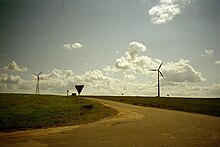Naratsch
| Naratsch | ||
|---|---|---|

|
||
| Bank of the Naratsch | ||
| Geographical location | Minskaya Woblasz , Belarus | |
| Drain | Naratsch | |
| Data | ||
| Coordinates | 54 ° 52 ' N , 26 ° 47' E | |
|
|
||
| Altitude above sea level | 165 m | |
| surface | 79.2 km² | |
| length | 12.8 km | |
| width | 10 km | |
| volume | 0.71 km³ | |
| scope | 41 km | |
| Maximum depth | approx. 25 m | |
| Middle deep | 8.9 m | |
| Catchment area | 199 km² | |
The Naratsch ( Belarusian Нарач , Russian Нарочь / Narotsch ) is the largest lake in Belarus and a place of the same name on its shore in the north of the country in the Minskaya Woblasz . In March 1916, the battle on Lake Naratsch took place here.
location
The lake is located in the middle of a landscape rich in forests and bogs and is the main destination of domestic tourism in Belarus. In its neighborhood there are guest houses, restaurants, dacha colonies and hotels. The lake is drained via the Naratsch River, which belongs to the Memel catchment area .
Relocation projects
On the southern shore of the lake is the municipality of Sanaratsch, which includes the village of Stachowzy. At the height between Stachowzy and Sanaratsch the settlement since the mid-1990s Druschnaja emerged. Resettlers from the radioactively contaminated southern part of Belarus, supported by Belarusian students and workcamp participants from Germany, have built houses in the clay-straw or clay-wood chaff construction. This project was initiated by Irmgard and Dietrich von Bodelschwingh as well as by the non-profit organization Heim-statt Tschernobyl eV they founded . With donations and public grants from Germany, the construction of two wind turbines not far from the village was financed: the only one in Belarus so far. In addition, an Orthodox church and a medical center were built in Sanaratsch. In 2005 the construction of an outpatient clinic began, which will be the first low-energy house in Belarus.
Ecological economy
Wind power
In the years 2000 to 2002 Heim-instead of Chernobyl built two wind turbines with 250 and 600 kW nominal power above Naratsch Lake near the Druzhnaya settlement, as well as a photovoltaic system on the roof of the workshop in Druzhnaya. The two wind turbines produce an annual average of almost 1.3 million kilowatt hours, which corresponds to the electricity requirements of 600 to 700 Belarusian households. The electricity generated is fed into the public grid for sale. The Belarusian partner organization ÖkoDom (“International Non-Profit-Social Association ÖkoDom”) uses the earmarked proceeds to finance further projects for families with radiation damage.
reed
Since 2003, the reeds of Lake Naratsch and other lakes in the Mjadel district have been harvested in winter, when the ice is firm enough and stable enough. The reeds were harvested by hand until 2004. A reed harvesting machine has been in use since winter 2005. The harvested reeds are processed into reed mats with a maximum thickness of 5 cm.
A reed board knotting machine from Sterflinger has been used for this for several years. After the company from southern Germany gave up its reed board production, it gave Heim instead of Chernobyl (or ÖkoDom) a well-preserved reed board knotting machine. The machine was rebuilt there after it was transported to Belarus.
The reed mats are used as insulating material for walls and roofs in the construction of further houses for resettlers in Staryj Lepel (on Lake Lepel) and in the construction of the outpatient clinic in Sanaratsch; but they are also exported. The use of the reed as an ecological, energy-saving building material not only offers jobs in its harvest and processing, but also prevents a deterioration in the water quality of the lakes.
Picture gallery
Web links
- Home instead of Chernobyl official homepage







